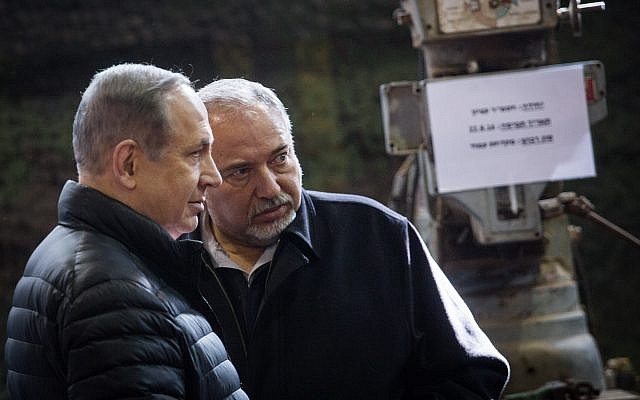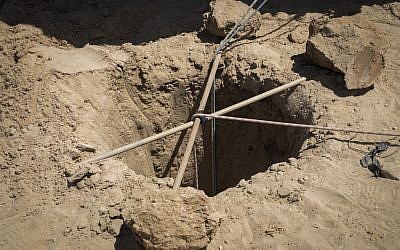5 Palestinians killed, 9 wounded in operation; Liberman says tunnel proves Gaza still a ‘kingdom of terror,’ but Israel not seeking escalation of hostilities

Prime Minister Benjamin Netanyahu and Defense Minister Avigdor Liberman on Monday hailed the IDF for destroying an attack tunnel from the Gaza Strip discovered near a kibbutz inside Israeli territory, with the two leaders attributing its discovery to Israel’s new “breakthrough technology.”
Israel destroyed the tunnel Monday morning. The Hamas-run health ministry in Gaza said at least five Palestinians were killed and 9 others were wounded when the IDF blew up the tunnel.
In remarks at the weekly Likud faction meeting, the prime minister said the long-rumored advanced technology to locate the attack tunnels had been utilized in the recent operation.
“I told you many times before that we are developing breakthrough technology to deal with the tunnel threat,” said Netanyahu at the start of the meeting. “We are implementing it. Today, we located a tunnel and we destroyed it.”
The prime minister said Israel holds Hamas responsible for all military action against Israel emanating from the Gaza Strip and “whoever hurts us, we hurt them.”
Also hailing the “breakthrough technology,” Liberman warned that Israel would not tolerate incursions on its territory, while stressing that Israel was not seeking renewed conflict with Gazan terror groups.
“I think the message is clear to all: We will not tolerate a breach of our sovereignty,” said Liberman at the start of the weekly Yisrael Beytenu faction meeting. “I emphasize that the explosion took place on our territory.”
The tunnel extending from the Gazan city of Khan Younis, believed to have been dug after the 2014 war, “proves that despite the Palestinian reconciliation, the Gaza Strip remains a kingdom of terror,” the defense minister said, referring to ongoing negotiation between the rival Fatah and Hamas factions.
“We have no interest in an escalation [in hostilities] and we have no intention of letting anyone hurt Israel’s sovereignty,” he added.
In a statement, Education Minister Naftali Bennett also commented on the attack tunnel, which he described as a “serious violation of Israel’s sovereignty.”
“Our enemies do not rest from their attempts to hurt the citizens of Israel. The IDF has learned from Operation Protective Edge and is using its intelligence, technology, engineering and operational abilities to stop such attempts and ensure the security of those living near Gaza. The neutralized tunnel is no longer a threat to the residents of the region,” said Bennett.
Earlier, the military said the tunnel had been under surveillance for an extended period of time and was under active construction at the time of the demolition.
The tunnel, which the IDF described as a “grave and unacceptable violation of Israeli sovereignty,” started in Khan Younis, crossing under the border and approaching Kibbutz Kissufim, the army said.
“The tunnel was detonated from within Israel, adjacent to the security fence,” the military said in a statement.
IDF spokesperson Lt. Col. Jonathan Conricus said the tunnel was at least two kilometers away from the Israeli town and did not pose a threat to its residents. Liberman also said no Israelis were endangered by the tunnel.
The demolition was carried out near the fence separating Israel from Gaza.
The tunnel was discovered by a new, advanced piece of technology that was being used for the first time, Conricus told reporters. He would not specify what type of equipment was used.
It was the third such tunnel that the military has said it’s destroyed since the 2014 Gaza war, known in Israel as Operation Protective Edge. However, the first two tunnels, which were demolished last year, were believed to be leftovers from the 2014 conflict, whereas the tunnel that was detonated on Monday was “in progress,” according to Conricus.
The destruction of the tunnel was first reported by Palestinian media on Monday afternoon. The reports said it was carried out by airstrike.
The IDF initially contradicted those reports, saying it was a “controlled demolition,” but Conricus later clarified that the military would not comment on what munitions were used.
The IDF officers said it was not immediately clear who dug the tunnel, but that ultimately the Israeli army holds Hamas “accountable and responsible” as it is the governing figure in the Strip.
Hamas did not immediately comment on the demolition.
The news site Palestine Today, which is affiliated with the Palestinian Islamic Jihad terror group, reported that a number of members from the group’s armed wing, Saraya Al-Quds, were incommunicado after the Israeli army destroyed the tunnel on Monday, but later in the day Hamas official media Al-Rai reported that three “resistance fighters” had been rescued.
Additionally, the spokesperson for the Hamas-run Gaza health ministry, Ashraf al-Qidre, said four people who were injured in the detonation were brought to the Strip’s Al-Aqsa Martyrs’ Hospital.
Hamas official media Al-Rai reported that three “resistance fighters” were rescued after the Israeli army detonated an attack tunnel dug from Gaza into Israel.
Additionally, the spokesperson for the Hamas-run Gaza health Ministry Ashraf al-Qidre said four injured by detonation of the tunnel were brought to the Strip’s al-Aqsa Martyrs’ Hospital.
Conricus would not comment on the dimensions of the tunnel, specifically its depth and length. The military could not confirm that the entire tunnel was destroyed.

“The IDF does not intend to escalate the situation but stands prepared for a variety of scenarios,” the army said.
The officer added that the “IDF is working above- and below-ground to thwart attempts to harm Israeli civilians and protect the relative calm in the area.”
The IDF set up additional Iron Dome missile defense batteries in the area in case terror groups in the Strip fired rockets in response to the demolition.
This summer, Israel began work on an underground barrier that is meant to counter attack tunnels. The army said the construction of the barrier was not connected to the discovery and demolition of Monday’s tunnel.
As reported by The Times of Israel
